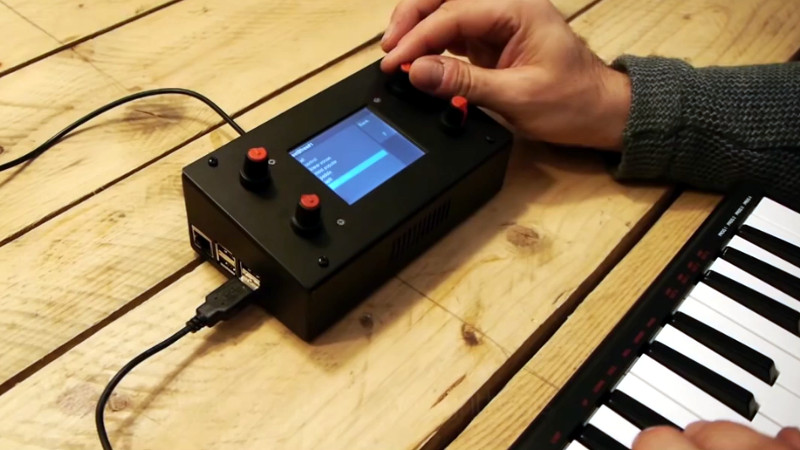Have you ever seen something and instantly knew it was something you wanted, even though you weren’t aware it existed a few seconds ago? That’s how we felt when we received a tip about Zynthian, a fully open source (hardware and software) synthesizer. You can buy the kit online directly from the developers, or build your own from scratch using their documentation and source code. With a multitude of filters, effects, engines, and essentially unlimited upgrade potential, they’re calling it a “Swiss Army Knife of Synthesis”. We’re inclined to agree.
 At the most basic level, the Zynthian is a Raspberry Pi 3 with a touch screen, a few rotary encoders, a dedicated sound card, and MIDI support. Software wise the biggest feature is arguably the real-time Linux kernel for the lowest latency possible. There’s also a custom web interface so you can control the Zynthian from another machine on the network if you want. As a matter of course, it also includes a wide array of pre-installed audio packages to experiment and create with.
At the most basic level, the Zynthian is a Raspberry Pi 3 with a touch screen, a few rotary encoders, a dedicated sound card, and MIDI support. Software wise the biggest feature is arguably the real-time Linux kernel for the lowest latency possible. There’s also a custom web interface so you can control the Zynthian from another machine on the network if you want. As a matter of course, it also includes a wide array of pre-installed audio packages to experiment and create with.
Kits are offered at various prices from $420 USD for the top of the line model down to unpopulated PCBs for a few bucks. We like that they broke things down this way; allowing users of various skill (and or patience) to pay what they want. If you just want to buy the custom boards and roll your own case and Pi solution, you can do that.
If you want to go all in, you can build one entirely from scratch as well. Everything from the CAD files for the case to their custom rotary encoder library is completely open (most licensed under GPL v3) for anyone to use however they see fit. There’s even a page in the wiki for listing hardware which isn’t officially supported by the project, but remain as options for those looking to cut their own path.
Synthesizers are a fairly popular hacker project, from Google’s AI-powered version to single chip exercises in frugality. If you want to learn even more about the fine line between digital noise and music, check out this fantastic series by our very own [Elliot Williams].
[Thanks to Mynasru for the tip.]
















“A Fully* Open Source Raspberry Pi Synthesizer”
* excluding the schematic of the Raspberry Pi and the blob used by its Broadcom SoC to boot up.
Still, it’s closer than a lot of the competition, so still a worthy project.
Came here for this comment.I knew there was going to be an issue with following the words Open Source with Raspberry Pi, but when will HAD authors learn!?
so its like laptop, but with a shittier user interface
but looks WAY cooler on stage
“Software wise the biggest feature is arguably the real-time Linux kernel for the lowest latency possible.”
“The Zynthian Software stack consist of…GNU Linux Operating System: Raspbian Jessie (Minibian is used in the last SD images)…”
http://wiki.zynthian.org/index.php/Building_a_Zynthian_Box_using_an_official_Kit_v2#Zynthian_Software
Is it real-time?
On he wiki they say it is the low latency preemptive kernel which for audio on an rpi3 should be sufficient
Kernel is built as preemptive and patched with preempt RT. It’s as realtime as it can get.
When the name is Zynthian, I expected it to run on the ZYNQ. I wonder if a port is possible.
B^)
zyn from zynaddsubfx
Of course! That makes sense.
+1
isn’t it strange, he uses an io expander to add 2 gpio, but the expander uses 2 gpio ?
The expander adds 16 GPIO (MCP23017) and uses 2 GPIO as IRQs.
I put together one of these without all the extra hardware. Just a Raspberry, a touch screen and a sound card. The UI supports just using a touch-screen – so you don’t need the rotary encoders.
Download the image, flash an SDcard, stick it in the Raspberry and boot up.
I plugged in a USB MIDI keyboard controller and voila, an amazingly capable synthesizer!
Glenn meander, can I ask which soundcard did you use , I already have the pi ,the touchscreen is on its way and I have a good midi controller with lots of knobs and faders, if you have it working great ,I’d like to buy the same card you did, thanks
Hi Glenn,
Can I ask you what’s the polyphony ? Is it mono timbral or multi – tiblar ? Would it be easy to add additional let’s say 8 encoders for real time modification of paramaters ?
Cheers
Why not just run AMSynth software on the Pi?
Will the Zynthian image run on a PI connected to an HDMI display?